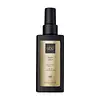What's inside
What's inside
 Key Ingredients
Key Ingredients

No key ingredients
 Benefits
Benefits

 Concerns
Concerns

 Ingredients Side-by-side
Ingredients Side-by-side

Cyclopentasiloxane
EmollientDimethicone
EmollientDimethiconol
EmollientBis-Cetearyl Amodimethicone
Helichrysum Stoechas Flower Extract
PerfumingPyrus Malus Fruit Extract
Skin ConditioningCamellia Sinensis Leaf Extract
AntimicrobialCarthamus Tinctorius Seed Oil
MaskingCitrus Limon Peel Oil
MaskingCitrus Limon Fruit Extract
MaskingVitis Vinifera Seed Extract
AntimicrobialSaccharum Officinarum Extract
MoisturisingGinkgo Biloba Leaf Extract
Skin ConditioningGlycerin
HumectantHydrolyzed Soy Protein
HumectantWater
Skin ConditioningHexylene Glycol
EmulsifyingButylene Glycol
HumectantCyclohexasiloxane
EmollientBetaine
HumectantVanillyl Butyl Ether
MaskingBehentrimonium Chloride
PreservativeQuaternium-91
Myristyl Myristate
EmollientHexapeptide-11
Skin ConditioningCetearyl Alcohol
EmollientEthylhexyl Methoxycinnamate
UV AbsorberPhenoxyethanol
PreservativePotassium Sorbate
PreservativeSodium Benzoate
MaskingParfum
MaskingLinalool
PerfumingLimonene
PerfumingGeraniol
PerfumingCI 60725
Cosmetic ColorantCyclopentasiloxane, Dimethicone, Dimethiconol, Bis-Cetearyl Amodimethicone, Helichrysum Stoechas Flower Extract, Pyrus Malus Fruit Extract, Camellia Sinensis Leaf Extract, Carthamus Tinctorius Seed Oil, Citrus Limon Peel Oil, Citrus Limon Fruit Extract, Vitis Vinifera Seed Extract, Saccharum Officinarum Extract, Ginkgo Biloba Leaf Extract, Glycerin, Hydrolyzed Soy Protein, Water, Hexylene Glycol, Butylene Glycol, Cyclohexasiloxane, Betaine, Vanillyl Butyl Ether, Behentrimonium Chloride, Quaternium-91, Myristyl Myristate, Hexapeptide-11, Cetearyl Alcohol, Ethylhexyl Methoxycinnamate, Phenoxyethanol, Potassium Sorbate, Sodium Benzoate, Parfum, Linalool, Limonene, Geraniol, CI 60725
Ingredients Explained
These ingredients are found in both products.
Ingredients higher up in an ingredient list are typically present in a larger amount.
Cyclopentasiloxane, or D5, is a silicone used to improve texture of products and trap moisture.
D5 is considered lightweight and volatile. Volatile means it evaporates quickly after application. Once evaporated, D5 leaves a thin barrier that helps keep skin hydrated.
It is also an emollient. Emollients help soften the skin and prevent water loss. Silicones create a silky texture in products. D5 helps other ingredients become more spreadable.
Studies show D5 is safe to use in skincare products. We recommend speaking with a skincare professional if you have concerns.
Learn more about CyclopentasiloxaneDimethiconol is a silicone that resembles the popular dimethicone. Like other silicones, it is an emollient. Emollients create a thin film on skin to prevent moisture from escaping.
This ingredient helps to create a silky texture and improve spreadability. Due to its high molecular weight and thickness, it is often combined with cyclopentasiloxane.
Limonene is a fragrance that adds scent and taste to a formulation.
It's found in the peel oil of citrus fruits and other plants such as lavender and eucalyptus. The scent of limonene is generally described as "sweet citrus".
Limonene acts as an antioxidant, meaning it helps neutralize free radicals.
When exposed to air, oxidized limonene may sensitize the skin. Because of this, limonene is often avoided by people with sensitive skin.
The term 'fragrance' is not regulated in many countries. In many cases, it is up to the brand to define this term. For instance, many brands choose to label themselves as "fragrance-free" because they are not using synthetic fragrances. However, their products may still contain ingredients such as essential oils that are considered a fragrance.
Learn more about LimoneneLinalool is a fragrance and helps add scent to products. It's derived from common plants such as cinnamon, mint, citrus, and lavender.
Like Limonene, this ingredient oxidizes when exposed to air. Oxidized linalool can cause allergies and skin sensitivity.
This ingredient has a scent that is floral, spicy tropical, and citrus-like.
Learn more about LinaloolParfum is a catch-all term for an ingredient or more that is used to give a scent to products.
Also called "fragrance", this ingredient can be a blend of hundreds of chemicals or plant oils. This means every product with "fragrance" or "parfum" in the ingredients list is a different mixture.
For instance, Habanolide is a proprietary trade name for a specific aroma chemical. When used as a fragrance ingredient in cosmetics, most aroma chemicals fall under the broad labeling category of “FRAGRANCE” or “PARFUM” according to EU and US regulations.
The term 'parfum' or 'fragrance' is not regulated in many countries. In many cases, it is up to the brand to define this term.
For instance, many brands choose to label themselves as "fragrance-free" because they are not using synthetic fragrances. However, their products may still contain ingredients such as essential oils that are considered a fragrance by INCI standards.
One example is Calendula flower extract. Calendula is an essential oil that still imparts a scent or 'fragrance'.
Depending on the blend, the ingredients in the mixture can cause allergies and sensitivities on the skin. Some ingredients that are known EU allergens include linalool and citronellol.
Parfum can also be used to mask or cover an unpleasant scent.
The bottom line is: not all fragrances/parfum/ingredients are created equally. If you are worried about fragrances, we recommend taking a closer look at an ingredient. And of course, we always recommend speaking with a professional.
Learn more about Parfum